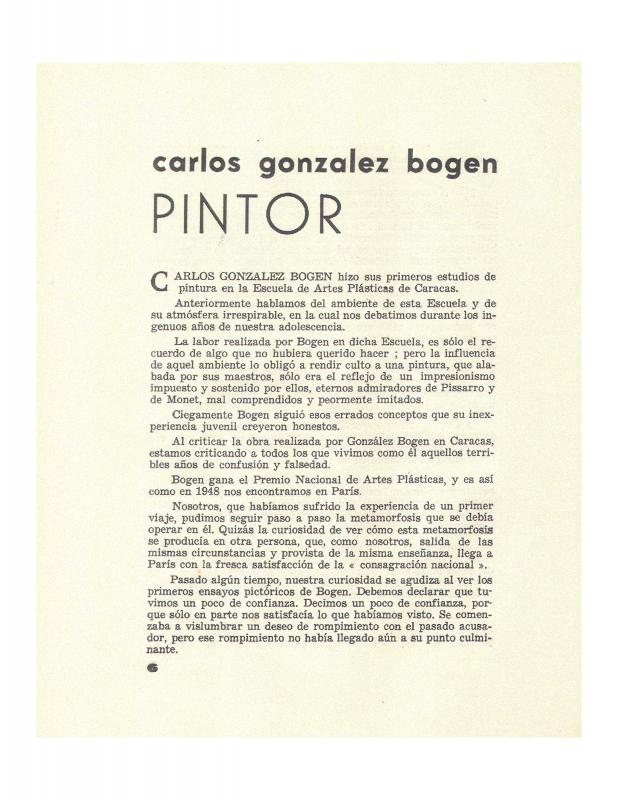Los Disidentes were a group created in Paris in 1950 by a number of Venezuelan artists and writers who lived in that city between 1945 and 1952. From the French capital they fought against the official education imparted by the Escuela de Artes Plásticas de Caracas, whose foundations were in landscape painting and nativism. True to their name, Los Disidentes tried to achieve a renewal of traditional and academic art through the assimilation of the values of European abstraction. The painters of that group included Alejandro Otero (1921–90), who wrote this text [see also doc. no. 813611], Pascual Navarro [doc. no. 813751 and doc. no. 813952], Luis Guevara Moreno, Carlos González Bogen [doc. no. 813695 and doc. no. 813667], Mateo Manaure [doc. no. 813583], Narciso Debourg [doc. no. 813597], Perán Erminy [doc. no. 813463], Rubén Núñez, Dora Hersen, and Aimée Battistini, as well as the then-student of philosophy J. R. Guillent Pérez [doc. no. 813478 and doc. no. 813723]. Other national artists who later joined their ranks include Armando Barrios, Miguel Arroyo, Oswaldo Vigas, Omar Carreño, Alirio Oramas, and Régulo Pérez. They published five issues of an eponymous magazine, Los Disidentes, which served as the chief conduit for disseminating their ideas.
The French diplomat and critic Gastón Diehl—object of the sarcastic article by Otero—came to Caracas for the exhibition De Manet a nuestros días, and stayed on for a decade as the cultural advisor of the French Embassy. Although in this article Otero takes on the voice of the group (he speaks in the first person plural), his comments on Diehl’s assertions go beyond accusation, which was his style. Although they express the radical position of Los Disidentes (in open opposition to Diehl), these are proposed within the sphere of ideas. The tone of the article makes one think that Diehl, although a conservative and ideal prey for the attacks of Los Disidentes, was actually a person that the young Venezuelans esteemed and whom they saw as an influential factor in the potential dissemination of their work. Proof of this is that upon his arrival in the Venezuelan capital, the Taller Libre de Arte organized a tribute to him.
In his article, Otero calls attention to the extreme courtesy conveyed in Diehl’s writings (and how these “courtesies” create difficulties when they “fall in the hands of Los Disidentes.”) He cites phrases used by the French critic that are common in diplomacy; for example, when referring to Venezuela he writes: “(…) many generations have contributed to establishing a solid artistic tradition which at times is linked to France’s through close ties.” But this profile, one that is courteous and hardly combative, is not exactly what Los Disidentes wished to attack; what Otero and his group wished to make clear is that which Los Disidentes rejected unequivocally: that Diehl attempts to offer “a defense of Impressionism that seeks to supplant the whole reality of today’s art.”










